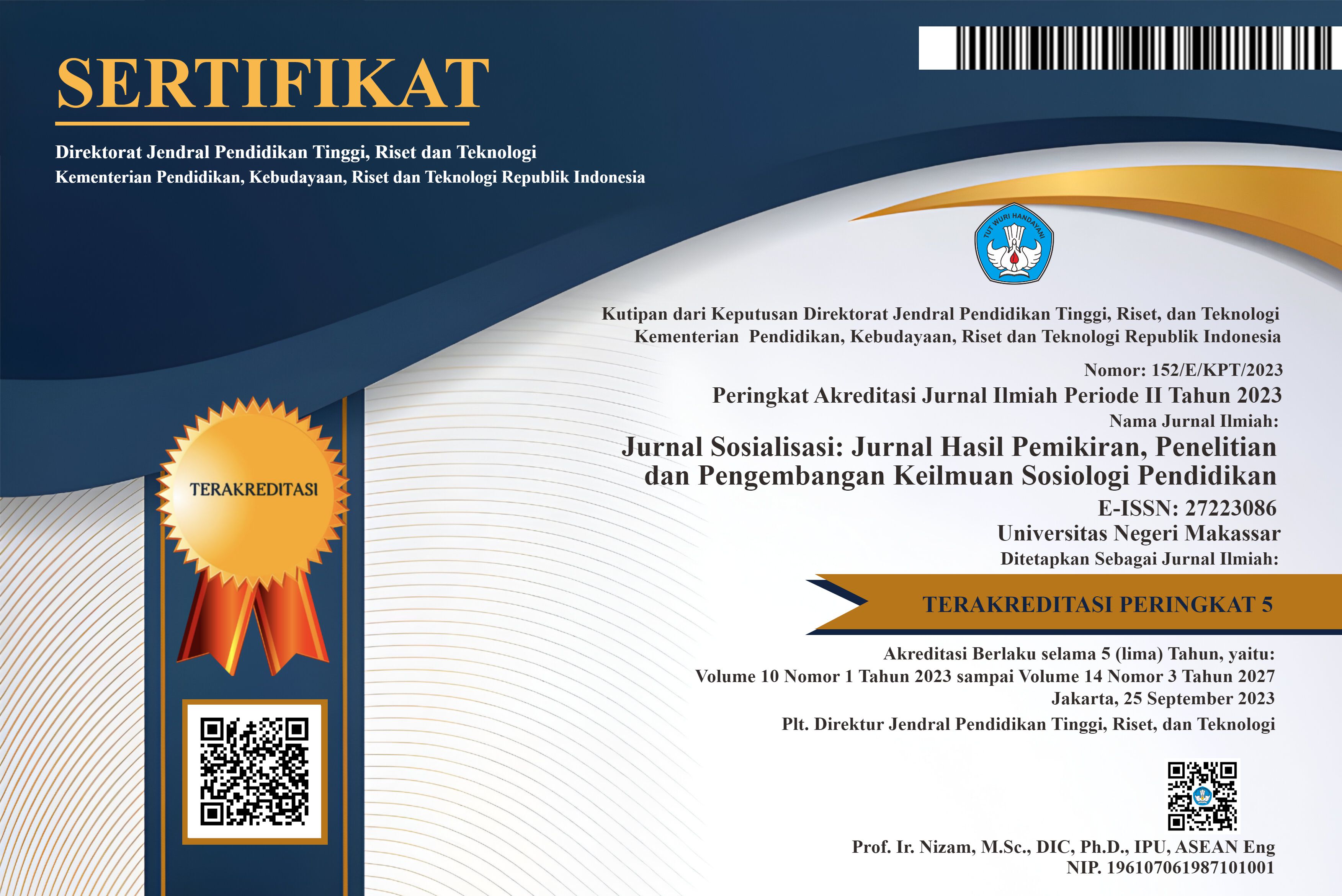Pengaruh In-group favoritism terhadap Perilaku Diskriminasi Pada Karyawan Etnis Tionghoa Di Makassar
(1) Fakultas Psikologi, Universitas Negeri Makassar, Indonesia
(2) Fakultas Psikologi, Universitas Negeri Makassar, Indonesia
(3) Fakultas Psikologi, Universitas Negeri Makassar, Indonesia
(4) Fakultas Psikologi, Universitas Negeri Makassar, Indonesia
(*) Corresponding Author
DOI: https://doi.org/10.26858/sosialisasi.v1i1.23221
Abstract
The purpose of this study is to measure the influence of in-group favoritism towards discrimination on the workplace, especially between Indonesian employees and Chinese workers. In-group favoritism of an individual will affect the discrimination in an organization. This study was conducted in Makassar, South Sulawesi. The participants of this study were 34 which consisted of 15 male and 19 female and came from private sector. This study used self-report to measure participants’ tendency towards two variables. In-group favoritism was measured by adaptation scale from (Luhtanen & Crocker, 1992), while discrimination variable used Lewis’ scale. Data analysis used regression model with SPSS 25 for Windows. The significance of hypothesis showed p = 0.35, which indicated the non significant result. The result of this study showed that in-group favoritism has no influence towards discrimination to Chinese workers.
Keywords
Full Text:
PDFReferences
Balliet, D., Wu, J., & De Dreu, C. K. W. (2014). Ingroup favoritism in cooperation: A meta-analysis. Psychological Bulletin, 140(6), 1556–1581. https://doi.org/10.1037/a0037737
Baron, R. A., & Branscombe, N. R. (2012). Social psychology (13th ed.). USA: Pearson.
Dasgupta, N. (2004). Implicit ingroup favoritism, outgroup favoritism, and their behavioral manifestasion. Social Justice Research, 17(2), 143–169. https://doi.org/10.1023/b:sore.0000027407.70241.15
Dovidio, J. F., & Hebl, M. R. (2005). Discrimination at the level of the individual: Cognitive and affective factors. In R. L. Dipboye & A. Colella (Eds.), Discrimination at work: The psychological and organizational bases. London: Lawrence Erlbaum Associates.
Jensen, G. G., Tischel, F., & Bornholdt, S. (2019). Discrimination emerging through spontaneous symmetry breaking in a spatial prisoner’s dilemma model with multiple labels. Physical Review, 100(6), 1–8. https://doi.org/10.1103/PhysRevE.100.062302
Johnson, M. K., Rowatt, W. C., & Labouff, J. P. (2012). Religiosity and prejudice revisited: In-group favoritism, out-group derogation, or both? Psychology of Religion and Spirituality, 4(2), 154–168. https://doi.org/10.1037/a0025107
Levin, S., & Sidanius, J. (1999). Social dominance and social identity in the United States and Israel: Ingroup favoritism or outgroup derogation? Political Psychology, 20(1), 99–126. https://doi.org/10.1111/0162-895X.00138
Lewis, A. C., & Sherman, S. J. (2003). Hiring you makes me look bad : Social-identity based reversals of the ingroup favoritism effect q. Organizational Behavior and Human Decision Processes, 90, 262–276. https://doi.org/10.1016/S0749-5978(02)00538-1
Lewis, G. J., & Bates, T. C. (2017). The temporal stability of in-group favoritism is mostly attributable to genetic factors. Social Psychological and Personality Science, 8(8), 1–7. https://doi.org/10.1177/1948550617699250
Lewis, T. T., Yang, F. M., Jacobs, E. A., & Fitchett, G. (2012). Racial/ethnic differences in responses to the everyday discrimination scale: A differential item functioning analysis. American Journal of Epidemiology, 175(5), 391–401. https://doi.org/10.1093/aje/kwr287
Luhtanen, R., & Crocker, J. (1992). A collective self-esteem scale Self-evaluation of one’s social identity. personality and social psychology bulletin. Social Science and Collections, 18(3), 302–319. https://doi.org/10.1177/0146167292183006
Scacco, A., & Warren, S. S. (2018). Can social contact reduce prejudice and discrimination? Evidence from a field experiment in Nigeria. American Political Science Review, 112(3), 654–677. https://doi.org/10.1017/S0003055418000151
Sellers, R. M., & Shelton, J. N. (2003). The Role of racial identity in perceived racial discrimination. Journal of Personality and Social Psychology, 84(5), 1079–1092. https://doi.org/10.1037/0022-3514.84.5.1079
Small, M. L., & Pager, D. (2020). Sociological perspectives on racial discrimination. Journal of Economic Perspectives, 34(2), 46–97. https://doi.org/10.1257/JEP.34.2.49
Verkuyten, M., Thijs, J., & Gharaei, N. (2019). Discrimination and academic (dis)engagement of ethnic-racial minority students: a social identity threat perspective. Social Psychology of Education, 22(2), 267–290. https://doi.org/10.1007/s11218-018-09476-0
Wagner, J. P., Grigg, N., Mann, R., & Mohammad, M. (2017). High task interdependence: Job rotation and other approaches for overcoming ingroup favoritism. Journal of Manufacturing Technology Management, 28(4), 485–505. https://doi.org/10.1108/JMTM-11-2016-0160
Zuo, Y., Chen, B., & Zhao, Y. (2018). The destructive effect of ingroup competition on ingroup favoritism. Frontiers in Psychology, 9(2207), 1–12. https://doi.org/10.3389/fpsyg.2018.02207
Article Metrics
Abstract view : 532 times | PDF view : 188 timesRefbacks
- There are currently no refbacks.

This work is licensed under a Creative Commons Attribution 4.0 International License.


































